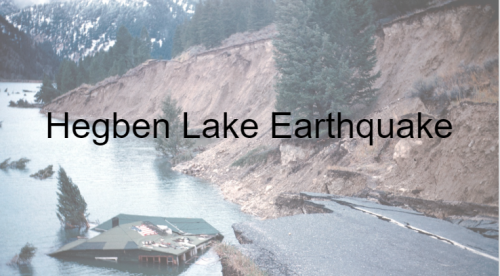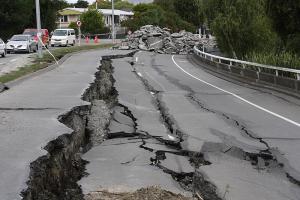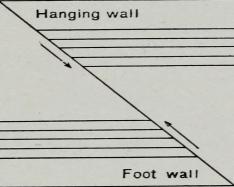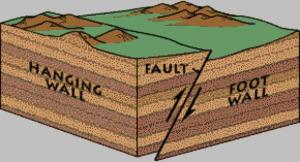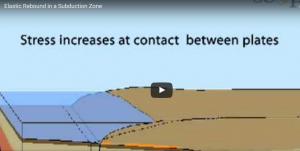Faults
Daily Dose of Destruction
The Earth's crust is constantly under stress. And you thought you had it bad. It is being squeezed, stretched, twisted, folded, lifted, and dropped 24 hours a day for millions of years. Eventually, the stress reaches its max and it must be released. When this happens, rock breaks, and faults are created. Faults are cracks in rock where the rock has moved on either side of that crack. Movement on either side of the fault, shifts in opposite directions. This fault movement causes vibrations in the crust. Those vibrations are called earthquakes.
There are three main types of faults: normal, reverse (thrust), and strike-slip (transverse). Normal faults happen when an area is being pulled apart by tensional forces. As the crust is stretched, part of the rock slides down the face on the other side of the fault. Each side of the fault has a name: Footwall and Hanging Wall. These can be differentiated by asking "Which side of the fault is leaning?" The leaning side is called the hanging wall, therefore the other side is called the footwall, or the side that is being leaned upon. The image below shows this.
The second type of fault is called a reverse or thrust fault. These faults are caused when the Earth is squeezed by compressional forces. The rock is pushed in opposite directions. The hanging wall is pushed up over the footwall.
The third type of fault is known as strike-slip or transverse fault. This happens when rocks slide past each other, parallel, but in opposite directions. This is caused by a force known as shear. Think of shear forces as scissors or shears (that shear sheep). Shears work because the two sides slide past each other. There isn't much movement up or down. You also wouldn't find hanging walls or footwalls in strike-slip faults. The San Andreas fault is an example of a strike slip.
The Earth is not as simple as you have seen in all of these diagrams. Some faults are caused by not just one, but two types of forces. Some slide past each other and drop/rise at the same time. The San Andreas mostly is a transverse fault, but it does have a hanging wall being pushed up by compression causing a little bit of a reverse fault as well.
The power behind an earthquake is caused by built-up stress near faults. When parts of the Earth just can't take any more stress, it literally snaps. The elastic limit is the limit to how far rocks can bend before breaking. Imagine pulling a rubber band in opposite directions. With enough force, you can break the rubber band, but watch out, because this can create pain caused by the rebound of the elastic material, rubber. Earthquakes are similar. They are stretched or squeezed until so much stress builds up that the rock will break and then snap almost back into the rock's original shape. This is called the Elastic Rebound.
In this next activity, you are going to use Google drawing to demonstrate your understanding of the different types of earthquake faults and show which part of the fault is the hanging wall or footwall.
If you are a student at Snowflake, Heber, or Holbrook click SUSD5 Student version of the Google Drawing Earthquake Faults assignment.
Purchase the Google Drawing Earthquake Faults assignment at Teachers Pay Teachers for $0.75 cents.










